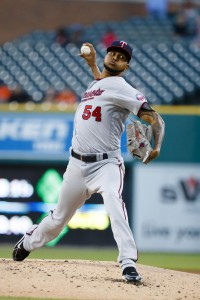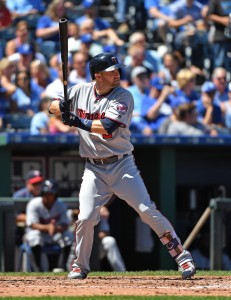MLBTR is publishing Offseason Outlooks for all 30 teams. Click here for the other entries in this series.
After a promising 2015 season that led many to believe the Twins’ lengthy stay in the AL Central cellar had reached its conclusion, nearly everything that could go wrong for Minnesota did in 2016. The Twins lost 103 games, prompting baseball’s most loyal ownership group to move on from GM Terry Ryan along the way. A new front office regime will look to guide the team back to prominence in the AL Central.
Guaranteed Contracts
- Joe Mauer, 1B: $46MM through 2018
- Phil Hughes, RHP: $39.6MM through 2019
- Ervin Santana, RHP: $28MM through 2018 (plus 2019 club option)
- Brian Dozier, 2B: $15MM through 2018
- Byung Ho Park, 1B/DH: $9.25MM through 2019 (including $500K buyout of 2020 club option)
- Glen Perkins, LHP: $7.2MM through 2017 (including $700K buyout of 2018 club option)
Arbitration Eligible Players (service time in parentheses; salary projections via MLB Trade Rumors)
- Trevor Plouffe (5.162) – $8.2MM
- Hector Santiago (5.016) – $8.6MM
- Brandon Kintzler (5.003) – $2.2MM
- Eduardo Escobar (4.128) – $2.9MM
- Kyle Gibson (3.056) – $3.5MM
- Ryan Pressly (3.053) – $1.1MM
- Non-tender candidates: Plouffe, Escobar
Free Agents
- Kurt Suzuki ($6MM option did not vest)
Other Financial Commitments
- Ricky Nolasco: $5MM paid to Angels through 2019 ($4MM for 2018 salary plus $1MM buyout of 2019 option)
Twins depth chart; Twins payroll information
The decision to move on from Terry Ryan was a fairly stunning development for the Twins this summer, as Ryan was one of just three general managers that the notoriously loyal Twins had employed dating back to 1985. Minnesota has been perceived as one of the most traditional organizations in the game, which made the hiring of 33-year-old Derek Falvey as the team’s new top baseball executive a significant departure from the status quo. Joining Falvey will be longtime Rangers assistant GM Thad Levine, who’ll receive a titular promotion to GM but still serve as second in command in his new organization. They’ll be complemented by longtime Twins AGM Rob Antony, who served as interim GM following Ryan’s departure but will return to his previous post following the new hires. At their introductory press conference, Falvey and Levine spoke about building out the club’s analytics department as well as the entire front office staff.
There are any number of issues facing the Twins’ new leadership team, though they won’t need to find a manager, as Paul Molitor will return for his third year on the job at the behest of owner Jim Pohlad. The Twins will be looking for a new hitting coach, though, after firing Tom Brunansky from that role earlier this week.
Beyond that, the first order of business will be to determine whether the club needs to embark on a total reset and further prolong what has already been a lengthy residence in the American League Central cellar (minus a one-year flirtation with a Wild Card spot in 2015). Falvey, perhaps unsurprisingly, didn’t commit to a clear direction during his introduction to the Twin Cities, instead speaking somewhat vaguely about a desire to deliver a “championship-caliber” baseball team, focusing on the long-term health of the organization and keeping an open mind to all scenarios.
Reading between the lines a bit, Falvey did praise the work that the previous regime had done in compiling a nice core of young talent on the position-player side of the spectrum, implying what anyone who has followed the Twins even remotely already knew: the pitching staff is in need of a major overhaul. Outside of Ervin Santana, Minnesota’s rotation is rife with uncertainty.
Former first-round pick Kyle Gibson took a marked step back in 2016 and dealt with shoulder injuries. Phil Hughes underwent thoracic outlet syndrome surgery this summer and hasn’t looked anywhere close to his 2014 breakout in either of the past two seasons. Hector Santiago was acquired to be an upgrade over Ricky Nolasco, but he regressed immediately upon joining the club and posted a 5.58 ERA in 61 innings with the Twins. Young right-hander Jose Berrios, lauded as a top 25 prospect by most pundits, was shelled for an 8.02 ERA in 58 innings, and sophomore Tyler Duffey followed up a terrific rookie effort with a 6.43 ERA in 133 innings (albeit with considerably more promising peripherals).
In the bullpen, Glen Perkins made just two appearances before a shoulder injury ended his season, while starter-turned-setup-man Trevor May dealt with back problems and turned in a poor season of his own after showing great promise in 2015. Veteran setup man Kevin Jepsen pitched so poorly that the Twins released him. Hard-throwing relief prospects J.T. Chargois and Pat Light (acquired from Boston this summer) both struggled in the Majors. Rookie left-hander Taylor Rogers was a bright spot all year, though he wilted in September.
Whatever course the Twins set this offseason, it’s clear that some rotation additions are needed. The team does have another MLB-ready arm at Triple-A in the form of Adalberto Mejia (acquired from the Giants in the Eduardo Nunez trade), while 2014 first-rounder Tyler Jay and 2013 fourth-rounder Stephen Gonsalves had nice years in the minors. But given the rampant uncertainty that permeates their staff, the Twins need additional innings. It wouldn’t be prudent for Minnesota to ink one of the top starters and allocate tens of millions of dollars at mid-rotation arms as they so frequently did in recent offseasons, so look for lower-cost alternatives. Left-hander Derek Holland saw his option declined by the Rangers and is obviously a very known commodity to new GM Thad Levine, for instance, as is right-hander Colby Lewis (in whom the Twins had interest when he was first returning to MLB from Japan).


